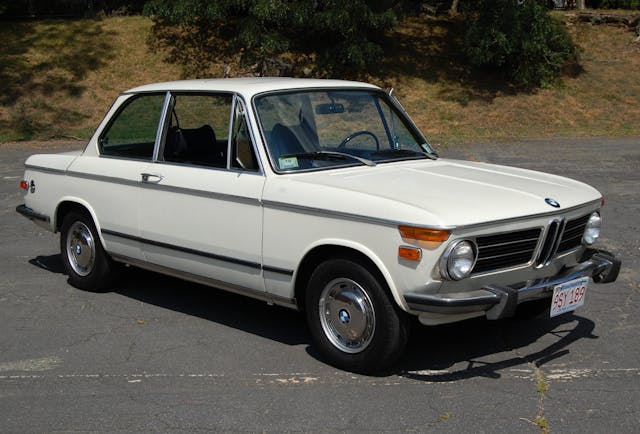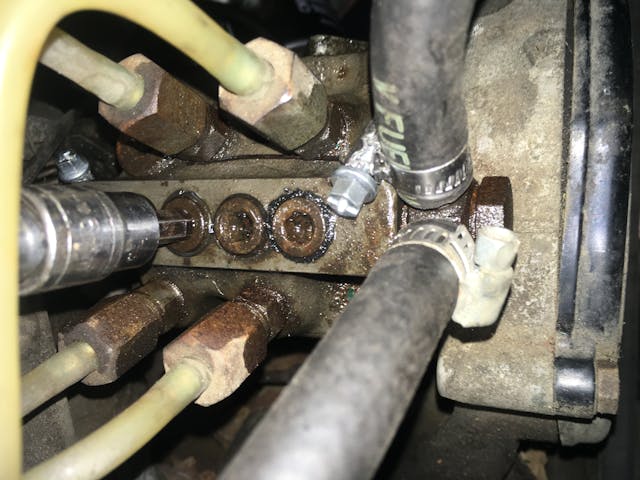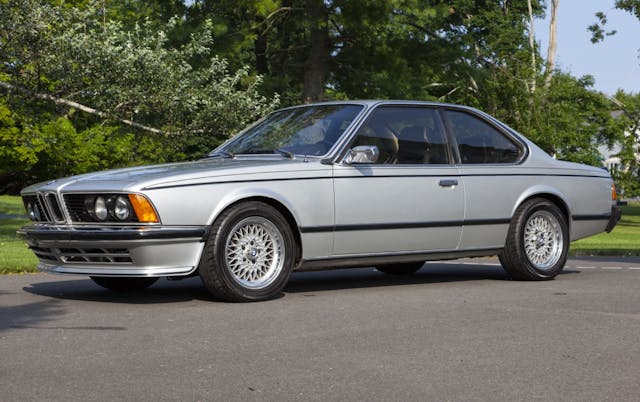Balancing risk and reward when buying a car

I’ve been tough on Bring a Trailer, the high-end version of eBay and Craigslist. As I wrote here, Bat’s lead time can be maddeningly long, and its business model of writing dry, “curated” descriptions that are engineered to insulate the site from liability—paired with encouraging sellers to comment and engage readers in order to crowd-source the truth (whatever the truth is)—creates the illusion that BaT is offering vetted products when they’re really not. That is, no BaT-employed marque expert ever examines the car. It rubs me the wrong way.
However, there’s no denying the success of the site, and the fact that, if you’re a seller with a desirable piece of merchandise, the two-people-want-it-and-up-goes-the-bidding process can create spectacularly high sales prices for a click-and-buy website.
I wrote in December about successfully selling a car on BaT for a friend, and I’m in the process of selling “Hampton,” the 49K-mile survivor 1973 BMW 2002 that I bought in Bridgehampton, New York, in 2019. By the time this piece runs, the auction will have closed. Obviously, I don’t know the final result yet, but it has me thinking about risk and reward.

When it comes to buying cars, I am a notoriously risk-averse guy. I’m very hesitant to believe anything about a car unless I see it with my own eyes or have one of a handful of folks that I trust look at it for me. I’ve just seen too many pretty cars that, when you crawled under them, had rust-through.
And I had a near-miss. I remember the time a few years back when I was negotiating to buy a BMW 2002 that had what was likely the earliest VIN in the country. It was marooned in a closed service station. The son of the owner of the station was a Facebook friend of mine, a BMW guy who, although he wasn’t technically representing the car, said that he was familiar with it and that it was rust-free. I asked him if he’d looked underneath the car, and he said yes. Still, I wanted independent confirmation from another friend who could take a look at the car up on the service station’s lift. My friend found a rust hole on the inside face of the left frame rail—the side you can’t see just by bending down next to the car, which was what my FB friend had done—big enough to put three fingers through.
My not-technically-representing-the-car FB friend was livid and apologetic about saying the car was rust-free when he hadn’t actually verified it for himself. The lesson is that people bare-faced lying, or lying to both themselves and you, aren’t the only ways you can get burned. People can also, as was the case here, say things in good faith that they think are true, but aren’t. So, yeah, I’m risk averse.
The traditional advice for buying cars is to buy the best example in the best condition you can find, as that will be the one most likely to appreciate the most (you’ll sometimes hear this phrased, “You can never spend too much; you can only buy too early”). That’s fine if you have that kind of money, but I tend to buy needy cars costing in the low single thousands of dollars. My logic is that if I spend 30 grand on a car and I’m half wrong about it for some reason (originality, condition, rust, mechanical needs, whatever), I’m out 15 grand, but if I spend four grand and I’m half wrong, I’m only out two grand. Hey, it’s warped logic, but it’s my warped logic, and this is all about doing what makes sense to us.
Of course, the downside of my approach is that it dramatically limits your upside; the odds that you’ll buy a needy car for four grand, lay hands on it, poke here and fix that, and quickly sell it for 30 grand are very slim. As the saying goes, with great risk comes reward.
With that, here are some stories and thoughts:
The myth and reality of barn-find cars
Obviously, there were “barn find” cars before Tom Cotter’s series of books, but the popular culture largely owes the image and myth of the barn find to him. Here’s the deal, however. The image of a cobwebbed, dusty, and unmolested time-capsule split-window ’Vette “fresh from the barn” is a romantic one, but a car isn’t as inert as other barn prizes like antique furniture. There is nothing “fresh” about a barn-find car. Maybe “ripe” is a better term. Barns are terrible places for cars. Yes, rust-wise, a car in a barn is way better than a car sitting outside in the rain, but they’re typically porous environments—mice get in, chew upholstery and wires, nest in every crevice, urinate and defecate everywhere, and crawl inside heater boxes and die, something that reveals itself in spectacular fashion when you turn on the heat. I’ve opened the door in barn-find cars and experienced a wailing rodent-laid stench that would stun a wildebeest. Romantic? Feh. The only romantic analogy is that you’ll need a shower after both.
Plus, whether they’re in a barn or not, cars that sit for decades typically need reams of work. Dry-rotted flat tires and seized brakes are just the beginning. The rings and pistons seize to the cylinder walls, old gas turns to gooey varnish, the clutch sticks to the flywheel, and the rubber seals in the brake and clutch hydraulics harden, crack, and then dissolve. Dead cars may be cheaper than running ones, but if you can’t drive the car, there’s inherently a lot more risk; there’s no way to evaluate if it needs a transmission, a differential, or other major mechanical component.
The odds that you’ll just change the oil and throw a gallon of gas and a battery in it and be living the dream are slim. Thus, even if the car is an unmolested example that’s original right down to the filters, many of those parts are going to need to be changed in order to get the car drivable and safe, and the more original you want to keep it, the more challenging and expensive that’s going to be. Add to that the cosmetic rejuvenation you’ll need to perform to deal with the degradation, and the financial advantage of a barn find can quickly evaporate. In order for the purchase to make more sense than spending additional money and buying a running-and-driving example, the car’s value and your experience evaluating its condition need to be aligned with each other.
This was the case when I bought “Hampton,” my car on BaT. It hadn’t exactly been sitting in a barn for a decade—really, it was more of a large attached garage with a cement floor. The seller was the original owner, and her claim that the car’s 49K miles were original jibed with both its condition and the somewhat sparse service records. I marveled at the lack of rust, the original front fenders, and the car’s time-capsule interior. I unseized the brakes and rotated the engine but was concerned that the non-stock black coating in the engine compartment was masking accident damage. I bought the car, but it was only after I got it home that I found that the coating was only Ziebart-like rustproofing which was removable a few square inches at a time with solvent. It wasn’t hiding anything, and I felt that its survivor status extended to zero bodywork and the paint still being original.

I paid more for Hampton than for any other 2002, but when the BaT auction closes, I’ll be rewarded for my effort and my taking the risk. It’s something of a bellwether event for me, an indication that I should stop buying junk and instead put more money on the table and take more risk (although you could argue that by schlepping down to Long Island and back with a trailer so I could see the car with my own eyes before making a decision, I was already doing what I could to drive risk as low as I could get it).
Getting to the root cause
If a car has been parked for decades, there’s often a reason why. Sure, the owner may simply have stashed a “ran when parked” car while he or she was moving and then never got back to it (as was the case with Hampton), but it’s also possible that something big and bad happened to the car, and it was stuffed into a convenient barn to delay judgement on its fate. Such turned out to be the case with “Louie,” the 1972 2002tii I wrote a book about (Ran When Parked).
The car wasn’t a classic barn-find; it had been sitting under a carport in Louisville, Kentucky (“carport-find” doesn’t quite have the same cachet). After I got it running, I found that the car had a persistent oil leak from the top rear corner of the head. I eventually discovered that the head was cracked—not through a combustion chamber, but through a boss on which one of the threaded valve cover posts sits. I found RTV injected into the crack from the inside of the head, so clearly someone was aware of it. The fellow from whom I’d bought the car knew nothing about it; I believe he’d bought it from the son of the long-time owner. Over time, I came to assume that it was likely that the expense of replacing or repairing the cracked head was the reason the car had been parked. (The crack eventually yawned open on me during a road trip. I fixed it with J-B Weld. I’d planned to pull the head, but instead, I’m still driving it that way.)
The point is that when you buy a long-dead car, the seller may tell you that it “ran when parked,” and maybe it did, but you need whatever price you pay to factor in the distinct possibility of more than just normal-sitting sort-out. And yet, if you assume every dead car needs an engine and a transmission and a differential, your zero-risk offer would be “you should pay me to take this away,” and you’d never buy anything. So you always have to assume some risk. Of course, having owned dozens of the same car, as I’ve done with 2002s, and having a garage filled with parts, dramatically lessens this risk. (Commenters asked last week why I don’t own anything American. It’s not the “American” part; it’s the “different” part. I lost my bloody shirt on the Lotus because it was so different, so much of my knowledge didn’t apply, and I had zero spare parts.)

Other people’s risk is your opportunity
I found Louie, the ’72 2002tii, because it had been floated for sale on a Facebook 2002 forum. It was described as original, solid but with patina on the paint (rust blisters that had been sanded off and sprayed with the closest hardware-store match to the car’s green paint), not having run for a decade, and having a title issue.
All 2002tiis have a Kugelfischer mechanical fuel injection system that uses a crankshaft-driven pump, similar to old diesel systems as well as the early Bosch injection systems in gas Mercedes. Many people have heard that the system is arcane and finicky. Really, they’re not; you just need to know a few things. The title issue was that the title and registration had been stored in the glovebox and were literally eaten by mice; a photo showed the shredded remains. The current owner tried, but getting a duplicate title was not productive.
The prospect of a rust-blistered, title-less, decade-dead car with an obsolete mechanical injection system and a reputation for requiring goat entrails for resurrection put off many people. The seller got frustrated and offered the car to me for a drop-everything price. I’ve owned almost a dozen tiis and had recently resurrected two, plus I like cars with patina, and I was aware of a few techniques for dealing with old cars without titles (see the oft-requested links to my two stories on The Vermont Loophole), so what frightened others didn’t bother me at all. I bought the car, went to Louisville, resurrected it in place, drove it home, bonded with it, love it, and hope to keep it forever.

Your priorities and other people’s strange choices
About six years ago I went to Southeast Sharkfest, an event for BMW E24 6 Series cars as well as the E9 and E31 coupes that share the inward-slanting “shark” nose. While there, I was captivated by a silver Euro-spec 635CSi with black stripes and the small European bumpers. The combination of the close-in Euro bumpers and the stripes that broke up the sides and continued onto the front air dam gave the car a great hunkered-down look. I began searching for one and found a car listed on both Craigslist and eBay. It had exactly the look that slayed me at Sharkfest, and it was close enough (Berlin, Connecticut) that it was only an hour and a half each way to have a look at it in person.
The car was beautiful and essentially rust free, but it had several substantial demerits. It was missing its original Euro-only 218-horsepower M90 engine and dog-leg five-speed gearbox, both replaced with U.S.-spec components. It had nearly 220K on the odometer. The inner fender walls in the engine compartment clearly showed signs of rework, indicating the car had been crashed. And it didn’t have air conditioning. Unfortunately, the seller’s asking price was close to what the car was worth if it had its original drivetrain, 2/3 the mileage, A/C, and no accident damage.
I loved the look of the car, but as pretty as it was, it wasn’t worth close to what he was asking, and it’d never bring all the money if I ever wanted to resell it, so it was important not to let my automotive hormones overrule my rationality.

In addition, the seller had made some odd choices. Although he’d sprung for a set of expensive refinished BBS RA wheels and an Alpina steering wheel, the car’s gas tank was leaking, and the wipers were non-functional due to a bent linkage assembly. Not surprisingly, many people called, came, looked, and left. I liked the car, but the seller and I couldn’t come to agreement on price. I made sure, though, to part on good terms. I kept looking longingly at the photos but resisted the temptation to drunk dial the seller in a weak moment.
Several months later, the seller emailed me saying that he still had the car, he’d bought another project, needed the garage space, and was willing to deal. He still thought the refinished wheels and steering wheel had more value than I did, so in the end, we split those off. I literally drove down to Connecticut with a trailer and four spare wheels and a steering wheel, removed the ones on the car, installed the ones I brought, and loaded the car.

I still own the car and still swoon every time I look at it. Since 635CSis have come up a bit in value, whenever I sell it, I’ll make a little money. But that’s not the point. This one was a passion purchase with common sense acting as a trusted advisor. Knowing what I wanted, what the resale limits of the car were, and being willing to walk away and then come back were the keys to success.
It’ll be hard for me to recalibrate my buying habits, move off my bottom-feeding ways, and fish in the faster-moving waters. But even if I do, I think my triad advice of a) buy what you love, b) buy what you can afford, and c) don’t take on more risk than you’re comfortable with still roundly apply.
Happy hunting to us all.
***
Rob Siegel has been writing a column (The Hack Mechanic™) for BMW CCA Roundel magazine for 34 years and is the author of seven automotive books. His new book, The Lotus Chronicles: One man’s sordid tale of passion and madness resurrecting a 40-year-dead Lotus Europa Twin Cam Special, is now available on Amazon (as are his other books), or you can order personally-inscribed copies from Rob’s website, robsiegel.com.

